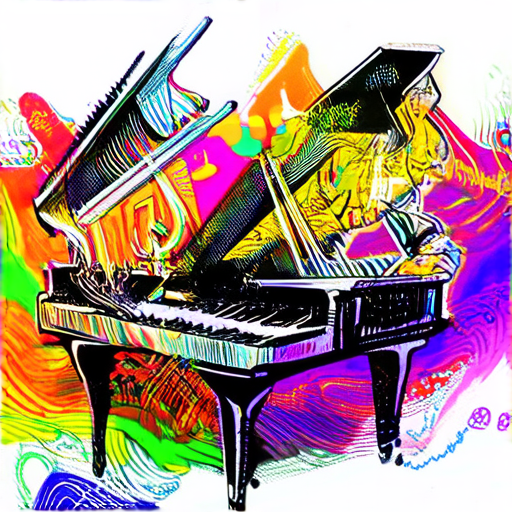For those who groove to the infectious rhythms and soulful melodies of funk music, playing its iconic sheet music can be a thrilling experience. However, deciphering the complex patterns and nuances of funk music sheet music requires a deep understanding of its underlying scales, chords, and drum patterns. From the question of what makes a piece of music truly funk to identifying the key instruments and classic standards that define the genre, mastering funk music sheet music demands a comprehensive approach.

Identifying Funk Music
Funk music is characterized by its strong bass lines, heavy syncopated beat, and distinctive groove.
- Bass Lines: Funk music often features prominent bass lines played by low-pitched instruments, which provide the foundation for the rhythm section.
- Syncopated Beat: A syncopated beat in funk music emphasizes off-beat rhythms, creating a sense of tension and release that drives the music forward.
- Distinctive Groove: Funk music’s unique groove is created by the combination of strong bass lines, syncopated rhythms, and percussive instrumentation, making it impossible to sit still.
Key Elements of Funk Music
- Rhythmic Complexity: Funk music often incorporates complex polyrhythms and time signatures, adding depth and interest to the music.
- Melodic Simplicity: Funk melodies tend to be simple and memorable, focusing on catchy hooks and riffs rather than intricate solos.
- Harmonic Progressions: Funk music frequently employs extended chords and altered dominants, creating a rich harmonic landscape that underpins the rhythm section.
Notable Funk Artists and Bands
- Tower of Power
- The Meters
- Parliament-Funkadelic
- Sly and the Family Stone
- Earth, Wind & Fire
Classic Funk Albums
- P-Funk’s “Maggot Brain” (1971)
- The Meters’ “Cabbage Alley” (1972)
- Tower of Power’s “Bump City” (1972)
- Sly and the Family Stone’s “There’s a Riot Goin’ On” (1971)
- Earth, Wind & Fire’s “That’s the Way of the World” (1975)
Modern Funk Influences
- Kendrick Lamar’s “To Pimp a Butterfly” (2015)
- Kamasi Washington’s “The Epic” (2015)
- Thundercat’s “Drunk” (2017)
- Vulfpeck’s self-titled debut (2011)
- J Dilla’s “Donuts” (2006)
Getting Started with Funk Music
To explore the world of funk music, start by listening to classic albums and artists, then branch out into modern interpretations and influences.
Visit our website at https://tigerfunk.com/ for more information on funk music and its many facets.
The Hardest Music Sheets to Play
When it comes to playing challenging music sheets, pianists often face a daunting task.
- Liszt’s La Campanella
- Rachmaninoff’s Piano Concerto No. 3
- Mozart’s Rondo alla Turca
- Chopin’s Etudes Op. 10
- Brahms’ Paganini Variations
Each of these pieces requires a high level of technical skill, musicality, and emotional expression.
- Technical Challenges: Liszt’s La Campanella demands lightning-fast arpeggios, intricate fingerwork, and precise pedaling control.
- Emotional Demands: Rachmaninoff’s Piano Concerto No. 3 requires a deep understanding of the composer’s expressive intentions, conveying a sense of drama and pathos.
- Complexity: Mozart’s Rondo alla Turca features complex rhythms, unexpected harmonies, and a relentless tempo.
- Expressive Nuances: Chopin’s Etudes Op. 10 demand a delicate touch, nuanced dynamics, and a deep understanding of the composer’s expressive language.
- Technical Showmanship: Brahms’ Paganini Variations require a mastery of advanced techniques, including double thirds, chromatic scales, and virtuosic finger dexterity.
In conclusion, the hardest music sheets to play are those that push pianists to their limits, requiring a combination of technical skill, musicality, and emotional expression.

Funk Music Scale
The funk music scale is primarily based on the harmonic minor scale, which provides a sense of tension and release.
- Harmonic Minor Scale: A harmonic minor scale consists of seven notes, with the seventh note raised a half step.
- Pentatonic Scale: The pentatonic scale is a five-note scale often used in funk music, particularly in bass lines and chord progressions.
- Blues Scale: The blues scale is a six-note scale that adds a flatted third and a flatted fifth to the major scale, giving it a distinctive sound.
- Modal Interchange: Modal interchange involves borrowing chords and scales from parallel modes or keys to add variety and interest to a piece.
In funk music, the harmonic minor scale is often used as a basis for improvisation, with musicians adding their own flair through modal interchange and other techniques.
- Chord Progressions: Funk music often features complex chord progressions that incorporate extended chords and altered dominants.
- Rhythmic Patterns: Funk music relies heavily on rhythmic patterns, including syncopated rhythms and polyrhythms.
- Melodic Motifs: Melodic motifs are short melodic ideas that are repeated and varied throughout a piece, often in a call-and-response pattern.
- Harmonic Function: Harmonic function refers to the role that chords play in a progression, including tonic, dominant, and subdominant functions.
By combining these elements, funk musicians can create complex and engaging music that showcases their technical skill and creativity.
Key Funk Scales
The following scales are commonly used in funk music:
- A Minor Pentatonic: A, C, D, E, G
- C Harmonic Minor: C, D, Eb, F, G, Ab, B
- G Blues Scale: G, Bb, C, Db, D, F
Improvising with Funk Scales
To improvise effectively with funk scales, focus on developing a strong sense of rhythm and phrasing, and experiment with different melodic motifs and harmonic functions.
Practice playing along with recordings of funk music, paying close attention to the solos and instrumental textures.
As you become more comfortable with the scales and techniques, try incorporating your own ideas and variations into your playing.

Elements of Funk Music
Funk music is a genre that originated in the mid-1960s, emerging from the Black R&B, soul, and jazz scenes.
- Rhythmic Patterns: Funk music is characterized by its strong emphasis on rhythmic patterns, often featuring syncopated bass lines and driving drum grooves.
- Groove-Oriented: Funk music is groove-oriented, focusing on creating a sense of energy and momentum through repetitive rhythms and melodies.
- Heavy Use of Percussion: Funk music makes extensive use of percussion instruments, such as congas, bongos, and timbales, to create complex rhythmic textures.
- Syncopation: Syncopation is a key element of funk music, involving the accentuation of off-beat rhythms to create a sense of tension and release.
- Bass Line: The bass line plays a crucial role in funk music, often serving as the primary melodic instrument and providing harmonic foundation.
- Harmonic Complexity: Funk music often features complex harmonies and chord progressions, adding depth and sophistication to the genre.
- Vocal Style: Funk vocalists often employ a distinctive style, characterized by emotive delivery, improvisational phrasing, and a focus on storytelling.
- Influences: Funk music draws influences from various styles, including jazz, rock, and African-American musical traditions.
- Cultural Significance: Funk music has played a significant role in shaping American culture, particularly during the 1970s and 1980s, influencing fashion, art, and social movements.
Key Artists and Bands
- P-Funk All-Stars
- The Meters
- Parliament-Funkadelic
- Sly and the Family Stone
- The Isley Brothers
- The Commodores
Evolution of Funk Music
Funk music has undergone significant transformations since its inception, influenced by technological advancements, social changes, and artistic innovation.
- Early Funk (1960s): Early funk music emerged from the Black R&B and soul scenes, characterized by simple, repetitive rhythms and minimal instrumentation.
- Mid-Period Funk (1970s): Mid-period funk saw the rise of more complex rhythms, extended instrumental solos, and increased emphasis on electronic instrumentation.
- Late Period Funk (1980s): Late period funk featured a blend of electronic and organic elements, incorporating synthesizers, drum machines, and sampling technology.
Legacy of Funk Music
Funk music continues to influence contemporary music, inspiring new generations of artists and fans alike.
- Influence on Hip-Hop: Funk music has had a profound impact on hip-hop, with many rappers drawing upon funk samples and rhythms in their productions.
- Influence on Electronic Music: Funk music has also influenced electronic music, with producers incorporating funk elements into their work.
- Cultural Impact: Funk music remains a powerful symbol of black cultural expression and resistance, continuing to inspire social change and activism.
What are 3 Characteristics of Funk?
-
Rhythmic Complexity
Funk music is characterized by its complex rhythms, often featuring syncopated beats and polyrhythms. This complexity creates a sense of tension and release, making funk music highly energetic and engaging.
-
Heavy Use of Bass
The bass guitar plays a crucial role in funk music, often taking center stage alongside the drums. A prominent bassline provides the foundation for the rhythm section, adding depth and texture to the overall sound.
-
Soulful Melodies
Funk music frequently incorporates soulful melodies, often drawing inspiration from blues, gospel, and R&B traditions. These melodies add an emotional resonance to the music, making funk a genre that’s both danceable and deeply felt.

The Key Instrument in Funk Music
The key instrument in funk music is undoubtedly the electric bass.
- Funk creates an intense groove by using strong guitar riffs and basslines played on electric bass.
- Likewise, Motown recordings feature basslines as the centerpiece of songs.
- In fact, funk has been called the style in which the bassline is most prominent in the songs, with the bass playing the hook of the song.
Tiger Funk’s Perspective
At Tiger Funk, we believe that the electric bass is the backbone of funk music.
- We’ve spent years studying the genre and have come to realize that the bassline is what sets funk apart from other styles of music.
- From James Brown to Parliament-Funkadelic, the bass has always been the driving force behind the funk sound.
- Whether it’s the iconic basslines of Bootsy Collins or the melodic bass playing of Larry Graham, the electric bass has been the key to funk’s enduring popularity.
Other Notable Bassists
Of course, there are many other talented bassists who have made significant contributions to the world of funk.
- Stanley Clarke is a highly influential bassist known for his work with Return to Forever and his solo albums.
- Victor Wooten is a versatile bassist who has worked with a wide range of artists, from Béla Fleck to Slightly Stoopid.
- Rufus Reid is a veteran bassist who has performed with everyone from Chaka Khan to Herbie Hancock.
Conclusion
In conclusion, the electric bass is the key instrument in funk music.
Its prominence in funk is unmatched, and its influence can be heard in everything from classic Motown recordings to modern-day funk revival bands.
At Tiger Funk, we’re proud to celebrate the art of funk and the incredible musicians who have helped shape the genre.

0 Comments